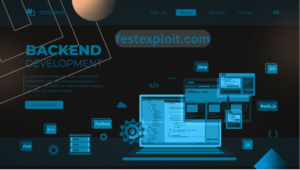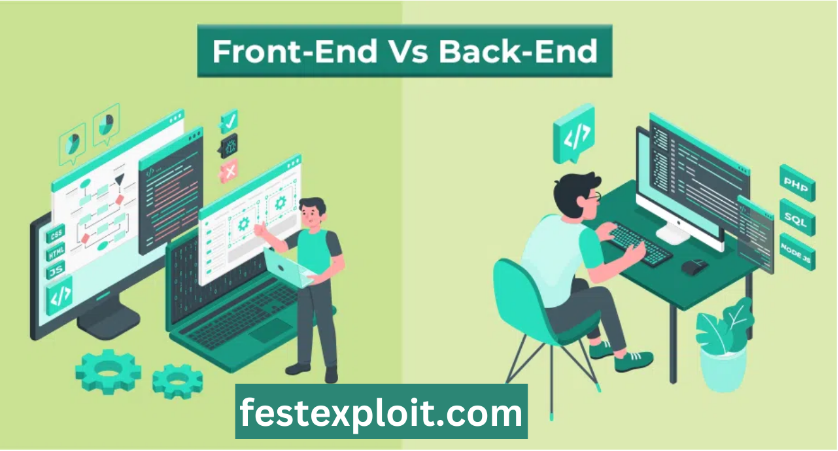Understanding the distinction between frontend and backend development is crucial in website development. Frontend vs Backend Web development forms the backbone of all websites and web applications, driving the interactivity and functionality that users expect from modern digital experiences. The front end serves as the user interface, the part of the site where users interact directly. It involves creating an intuitive, responsive design that meets users’ needs and expectations.
On the other hand, the backend is the server-side infrastructure, the unseen machinery that powers the front end, handling data management and server logic. Together, they form a cohesive whole, each contributing its own unique value. Developers, project managers, and stakeholders need to comprehend these two sides of the same coin, as they influence decision-making, resource allocation, and, ultimately, the success of any web development project.
Understanding Frontend Development

Frontend development, also known as client-side development, is essentially creating the visible part of the website or web application – the part that users see and interact with. This involves translating the website design into a functioning site using coding languages and tools. The primary role of a frontend developer is to ensure that the website layout is user-friendly, responsive and aligns with the design vision.
Key Languages and Tools
Frontend developers chiefly leverage three core languages: HTML (HyperText Markup Language), CSS (Cascading Style Sheets), and JavaScript. HTML provides the basic structure of sites, which is enhanced and modified by CSS – the language responsible for the style and appearance of the site. JavaScript, on the other hand, makes a site interactive, enabling dynamic content and user interaction.
Examples of Frontend Tasks
Examples of frontend tasks include creating a responsive design that adapts to different device screens, implementing navigation features, designing layouts, creating forms, and integrating multimedia assets like images and videos. The ultimate goal is to create an intuitive, engaging interface that offers a seamless user experience.
Understanding Backend Development

Backend or server-side development refers to all the activities behind the scenes to make the frontend function smoothly. This encompasses everything from server-side programming to database management, server configuration, and more. The primary role of a backend developer is to ensure that data or services requested by the frontend application or software are delivered efficiently.
Key Languages and Tools
Backend developers primarily use server-side languages like Python, Java, and Node.js. Python, known for its simple syntax and extensive library, is widely used in web and software development. Java, an object-oriented and versatile language, is preferred for its platform independence. Node.js, built on Chrome’s JavaScript runtime, is used for fast and scalable network applications. Additionally, backend developers extensively work with databases like MySQL, PostgreSQL, and MongoDB to store, retrieve, and manipulate data.
Examples of Backend Tasks
Backend development tasks involve server setup and management, database creation and management, application logic development, and smooth frontend-backend communication via APIs. Security measures are implemented to ensure data protection. Additionally, tasks include optimising for speed and scalability, implementing data storage solutions, and creating backend frameworks or architectures. The main goal of backend development is to support the frontend by managing data and ensuring server-side operations run smoothly.
Key Differences Between Frontend and Backend Web Development

Frontend and backend development, while intrinsically interconnected, exhibit several key differences. Below, we explore a comparison in terms of user interaction, languages used, and tasks.
User Interaction:
Frontend development directly interacts with users. It’s about creating an intuitive, engaging interface with which users navigate and interact. Conversely, backend development doesn’t have direct user interaction. It operates behind the scenes, ensuring the smooth functioning of the website or application by communicating with the server and databases.
Languages Used:
Frontend and backend development utilise distinct sets of languages. Frontend developers primarily use HTML, CSS, and JavaScript, essential to designing, structuring, and adding interactivity to the web interface. On the other hand, backend developers use server-side languages such as Python, Java, and Node.js, which are pivotal in server-side programming, creating application logic, and managing databases.
Tasks:
The tasks performed in frontend and backend development also vary greatly. Frontend tasks involve creating responsive designs, implementing navigation features, designing layouts, and integrating multimedia assets. Backend tasks, however, include setting up and managing servers, developing application logic, ensuring smooth communication between frontend and backend through APIs, and implementing security measures.
Development Focus:
A frontend developer’s primary role is translating the design into a functional interface, aiming for an engaging user experience. In comparison, a backend developer focuses on ensuring that data or services the frontend requests are delivered efficiently.
In summary, frontend and backend development are two sides of the same coin, each with its unique role and significance in web development. Comprehending the nuances of these domains is essential for successful web development projects.
Choosing Between Frontend and Backend Development
When deciding between frontend and backend development, several factors should be taken into consideration:
Personal Interest:
It’s essential to think about where your interests lie. If you’re intrigued by the visual side of websites, enjoy working on creating user-friendly interfaces, and have a knack for design, frontend development may be a good fit. On the other hand, if you’re more interested in how things work behind the scenes, enjoy problem-solving and working with databases, backend development could be the right choice.
Job Market:
According to the Bureau of Labor Statistics, jobs for web developers are expected to grow by 8% from 2019 to 2029, much faster than the average for all occupations. It’s advisable to research job openings in your location or where you intend to work. Look at the skills and experience employers seek for front and back roles.
Skills Required:
The skills required for frontend and backend development are quite different. Frontend development requires a solid understanding of HTML, CSS, and JavaScript, while backend development typically requires mastery of server-side languages such as Python, Java, or Node.js, and knowledge of databases. Assess your skills and consider which set aligns more closely with your strengths or areas you’re excited to learn more about.
Future Goals:
Consider your long-term goals. Backend development could be advantageous if you see yourself developing full-fledged applications, working on server architecture, or delving into machine learning. If you’re more drawn towards creating intuitive, visually engaging interfaces or interested in roles such as UX designer, front-end development might align more with your goals.
Ultimately, choosing between the front and backend should be considered a manageable decision. Many developers specialise in one area while also understanding the basics of the other, a path known as Full Stack Development. This balance offers a broader perspective and can open up more career opportunities.
Challenges and Solutions in Frontend and Backend Development
In the realm of web development, developers frequently encounter a variety of challenges. These issues range from frontend complications, such as browser compatibility and performance optimisation, to backend hitches, such as scalability concerns and database management issues.
Challenges Faced by Frontend Developers:
Browser Compatibility Issues
Frontend developers often grapple with browser compatibility issues, as browsers interpret and display code differently. These differences can lead to consistency in the user interface and experience.
Performance Optimization
Another common challenge is performance optimisation. Ensuring the website or application loads quickly and runs smoothly is crucial, but optimising images, CSS, JavaScript, and other elements for peak performance can be complex.
Challenges Encountered in Backend Development:
Scalability Concerns
Backend developers often face challenges related to scalability. As an application’s user base or data volume grows, backend infrastructure must handle this increase to maintain speed and performance.
Database Management Challenges
Backend developers also deal with database management challenges. These may include ensuring data consistency, managing complex queries, handling large volumes of data, and securing data.
Strategies and Best Practices for Overcoming These Challenges:
To overcome the challenges mentioned above, developers can employ various strategies and best practices:
Ensuring Browser Compatibility
Developers can use cross-browser testing tools to test the website’s functionality and appearance across browsers. Using a reset or normalised CSS can also help reduce browser inconsistencies.
Performance Optimization
For performance optimisation, developers can employ techniques such as compressing images, utilising lazy loading, minifying CSS and JavaScript, and leveraging browser caching.
Managing Scalability
Backend developers can use load balancing, microservices architecture, and other scalable technologies to manage increased demand. Developers should also consider scalability from the start of the development process.
Database Management
Developers can use database management systems (DBMS) to tackle database management issues and follow best practices such as data normalisation. Regular backups, security measures, and performance monitoring can also help manage databases efficiently.
The Future of Frontend and Backend Development
Emerging trends and technological advancements continue to shape the future of frontend and backend development. Artificial Intelligence (AI), Machine Learning (ML), and the Internet of Things (IoT) are becoming increasingly prevalent, promising to revolutionise web development.
Frontend Development:
In frontend development, we anticipate continued growth and evolution of JavaScript frameworks such as React.js, Vue.js, and Angular.js. Advances in CSS and HTML are also expected, enhancing creative design and interactivity possibilities. Furthermore, WebAssembly promises to bring a new level of performance to web applications by enabling high-speed code execution.
Backend Development:
In backend development, serverless architectures and microservices are expected to take centre stage. These approaches allow for more efficient scalability and resource allocation. Additionally, integrating AI and ML in backend development will take automation to new heights, making applications more innovative and efficient.
From a broader perspective, the line between frontend and backend development will likely continue blurring with the rise of full-stack development and universal frameworks that can run on both the client and server sides. This highlights the need for developers to have a well-rounded understanding of both domains.
Conclusion
In conclusion, both frontend and backend development have distinct roles and challenges in web development. The choice between the two should align with one’s skills, interests, and future career goals. However, gaining a foundation in both can offer more flexibility and open up a more comprehensive range of opportunities. The web development landscape continuously evolves, influenced by emerging technologies like AI, ML, and IoT. Developers need to stay updated and adaptable to navigate these changes and create web solutions that are efficient, scalable, and user-friendly. Witnessing the advances in this field and their potential for the future remains exciting.

